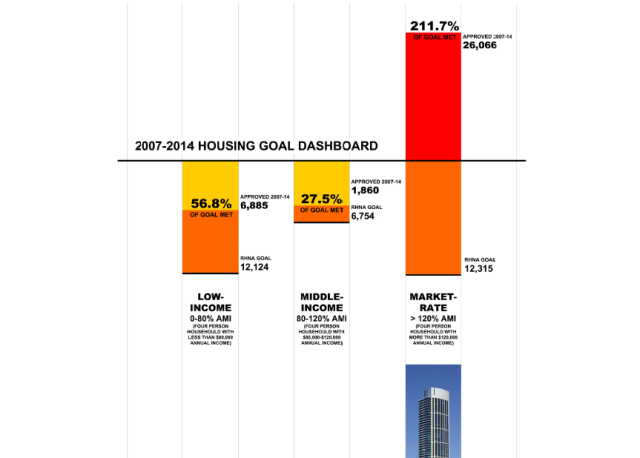The progressives are not the only ones saying that building more market-rate housing won’t solve the city’s problem

By Peter Cohen
AUGUST 19, 2015 — A few weeks ago, Gabriel Metcalf, the president of SPUR published a provocative article in a national on-line magazine casting blame for San Francisco’s housing affordability crisis on its progressive political activism.
The answer from Metcalf, of course, is: Build, build, build more market rate housing, because the problem is not enough supply, supply, supply of market-rate housing. It’s the same repetitive 1980s-style trickle-down economic theory mantra from SPUR and the pro-development boosters we’ve heard for the past two years.
At one level, it’s a curious time to point fingers when the mayor wants everyone to hold hands for this November’s affordable housing bond, and Gabriel Metcalf is actually on the bond’s campaign committee.
But what is really interesting is that Metcalf’s piece provoked several responses from outside the local progressive community.
First came an article and then an op ed by Mark Hogan, a local architect and principal at OpenScope Studio. Hogan is hardly a radical lefty.
Hogan asks, “Who is to blame? I have a hard time blaming progressives.” He goes on to explain:
Help us save local journalism!
Every tax-deductible donation helps us grow to cover the issues that mean the most to our community. Become a 48 Hills Hero and support the only daily progressive news source in the Bay Area.
“Looking back, nobody in the early ’90s would have predicted the level of immigration and income inequality we have now. Metcalf points out that we should have been building 5,000 units of housing yearly since then, but this is unlikely considering the realities of development in a cyclical regional economy and it would have seemed high prior to the first dot-com boom. Far more units have been permitted since then, but only a fraction of them have been built and this has more to do with economics than obstructionism.”
Thank you Mark Hogan. That pretty much debunks the Metcalf argument.
Then came an article from Robert Cruickshank, political commentator and writer for California Progress Report and for Calitics.
Cruickshank writes:
“Too often, the SF housing crisis is used to attack progressives from the right, in the service of free market solutions – even though, as the historical evidence makes clear, this crisis was not their fault. Progressives have spent the last two decades fighting to make SF more progressive. Had they been listened to, perhaps SF might still be affordable today.”
He concludes by saying:
“Ultimately SF is at the leading edge of a problem that is now facing all US cities. Urban America has become expensive. As we live in an era of increasing inequality, and in a time where macroeconomic policies favor investments that benefit the rich over those that benefit the poor or the middle, no market solution alone can solve the problem.”
Thank you Robert Cruickshank. That again debunks the Metcalf argument.
But finally came the kicker from William Fulton, who is considered by many to be California’s guru of city/urban planning. Fulton is the author of Guide to California Planning (now in its 4th edition), publisher of the California Planning & Development Report, former Mayor of Ventura and former vice president of Smart Growth America.
Fulton can fairly be described as a traditional politically centrist planner, not a radical or even a “progressive” as we think of thought-shapers in a San Francisco context. But this article is very insightful. Fulton clearly debunks the simplistic argument that increasing market rate housing supply will stabilize housing prices or even make housing prices overall more affordable.
The most salient excerpts:
“The problem is that under some market conditions, more supply doesn’t lead to market equilibrium because it actually creates its own demand… Santa Barbara has housing prices that are not supported by the underlying dynamics of the local economy, for one very simple reason: The uber-rich from around the world drive up home prices by paying premium prices, often for houses they don’t actually occupy very often. This throws the supply-demand equation out of whack; if you build more houses, the result might just be more uber-rich folks from out of town showing up to buy them, and that doesn’t help ordinary folks”
“That’s happening because the interplay between supply and demand is more nuanced than traditional economics would suggest, and because the interplay between the market and politics isn’t always rational.”
“The folks taking the cool jobs may not be uber-rich, but they have tons more money than everybody else, and so they drive prices out of sight. Build more market-rate housing, and you’ll just accelerate the cycle – more smart kids will show up wanting to work for tech start-ups, and that means you’ll have more tech start-ups, and pretty soon demand will rise faster than supply – in large part because you increased the supply.”
He does go on to show his generally pro-development position, which is fine and expected from Fulton. But the fact that William Fulton–a true planner’s planner–paints a definitive argument relevant to the San Francisco “market” that counters the local boosters is a key turning point in the seemingly endless debate about whether our crisis of affordability is simply solvable by increasing market-rate housing supply.
So, thank you William Fulton. California’s top planner really debunks SPUR’s Gabriel Metcalf on the theory of Trickle-Down housing policy.
In what seemed too perfectly timed to be simply ironic, the Sunday following Metcalf’s piece the Chronicle published an article on the front page business section titled: “Want a luxury apartment in San Francisco? You’re in luck”.
There couldn’t be a better “case study” to prove Fulton correct in his critique of the supply-side argument. Really, how much luxury housing does San Francisco truly need?
Peter Cohen is a “progressive” neighborhood activist and co-director of the Council of Community Housing Organizations





